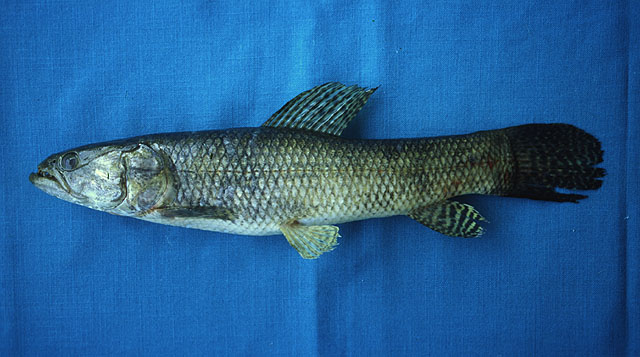| Erythrinidae (Trahiras) |
| 36 cm SL (male/unsexed) |
|
benthopelagic; freshwater |
| Central and South America: Pacific drainages of Panama; records in the Atlantic coast of Panama are restricted to the Canal Zone, suggesting dispersal through the Panama Canal; Puntarenas in southwestern Costa Rica; río Guayas basin in Ecuador and río Tumbes in northwestern Peru (Ref. 96873); and Colombia (Ref. 37025). |
|
Dorsal soft rays (total): 13-15; Vertebrae: 42-45. Hoplias microlepis is distinguished from all congeners, except species of H. malabaricus group, by the the shape of the dentaries abruptly converging towards the mandibular symphysis (vs. dentaries parallel and only gently converging towards the mandibular symphysis) and by having tooth plates on tongue (vs. absence of tooth plates on tongue). H. microlepis can be separated from H. brasiliensis and H. curupira by having 43-47 scales on lateral line (vs. 38-43 and 34-39, respectively), and from H. australis and H. lacerdae by having 4 pores of the laterosensory system along the ventral surface of dentary (vs. always 5 and 6-8 respectively). It differs from H. aimara by having accessory ectopterygoid and by lacking vertically elongate dark spot on the opercular membrane (vs. absence of accessory ectopterygoid and presence of dark spot). It can be diagnosed from the other members of the H. malabaricus species group by having more circumpeduncular scales (22-24, usually 24 vs. 18-20, usually 20) (Ref. 96873).
Description: Dorsal-fin rays ii, 11-13; anal-fin rays ii-iii, 7-9; pectoral-fin rays i,10-14; pelvic-fin rays i,7; longitudinal series of scales between lateral line and pelvic-fin origin 5.5-6.5 (Ref. 96873). |
| Inhabits rivers (Ref. 96873). Collected in creeks and swamps in areas of little or no current on sand and mud bottoms. Lives between 20 and 40 m elevation. Piscivorous (Ref. 36880). Reported to reach 50.0 cm TL (Ref. 9585). |
|
Least Concern (LC); Date assessed: 01 April 2019 Ref. (130435)
|
| harmless |
Source and more info: www.fishbase.org. For personal, classroom, and other internal use only. Not for publication.

